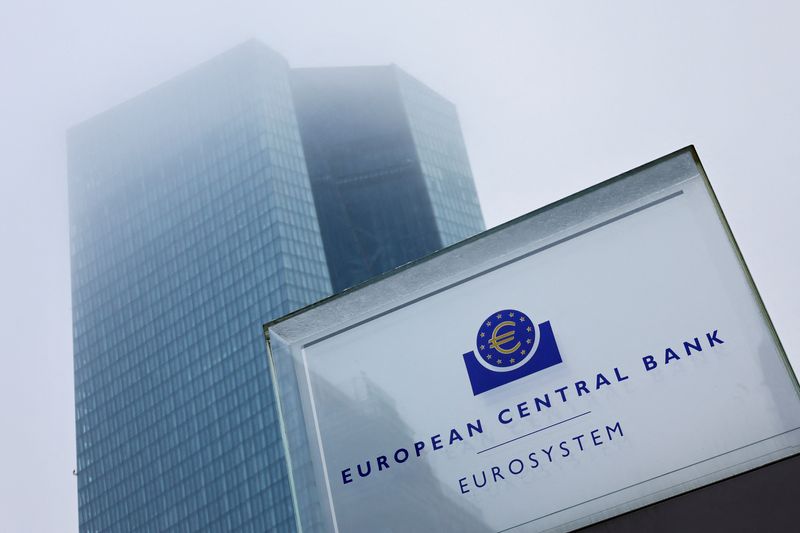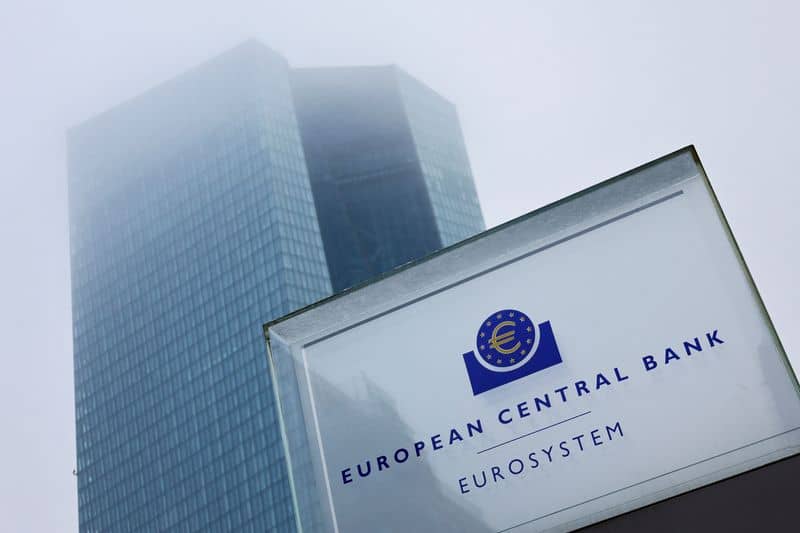 © Reuters. The building of the European Central Bank (ECB) is seen amid a fog before the monthly news conference following the ECB’s monetary policy meeting in Frankfurt, Germany December 15, 2022. REUTERS/Wolfgang Rattay/File Photo
© Reuters. The building of the European Central Bank (ECB) is seen amid a fog before the monthly news conference following the ECB’s monetary policy meeting in Frankfurt, Germany December 15, 2022. REUTERS/Wolfgang Rattay/File Photo
By Mike Dolan
LONDON (Reuters) – ‘Pushback’ has emerged as one of the financial market words of the year so far, but ‘humility’ could well take its place.
To varying degrees, top central bankers have this month attempted to dampen what they see as overexcited interest rate cut expectations in markets for 2024. And they’ve had some success – especially in longer term borrowing rates.
Warned again this week by the International Monetary Fund to “move cautiously” in opening a sluice gate of easing expectations with early rate cuts, Federal Reserve and European Central Bank officials have duly tried to prod markets away from assuming any initial easing before June.
But money markets haven’t given up the ghost just yet.
A quarter point Fed cut is more than fully priced by May – with more than a 50% chance of a move in the mix for March – and the first ECB easing is still odds on by April.
All still to play for?
An eye-catching line in the minutes from the December ECB meeting nodded to retaining caution but suggested it may be wise not to rule anything out just yet given the high degree of economic uncertainty still at play.
“It was widely regarded as important not to accommodate market expectations in the post-meeting communication,” the ECB said in a readout ahead of its next meeting next week.
But it added: “Some humility was advised with respect to judging market expectations given prevailing uncertainties.”
While it’s unclear whether it was advising humility on its own part or that of market traders, it could possibly be applied to both.
Year-end euphoria after the ECB’s Dec. 14 gathering saw the markets scramble to price an ECB rate cut as soon as March, only to face ubiquitous ‘pushback’ since that’s forced them to nudge that back to April. That’s remained the case even as ECB chief economist Philip Lane recently nodded to June at the earliest.
But just like the Fed, the ECB also appears to be giving itself considerable rhetorical wiggle room for the months ahead.
‘R-STAR’ GAZING
Key to that is a continued emphasis on keeping policy ‘restrictive’ – in party to bear down further on what it sees as still excessive wage inflation, even as the underlying euro economy flatlines and Germany toys with recession.
But retaining ‘restrictive’ policy leaves a wide range of options open – not least to act quickly if the data turns.
Despite myriad caveats, central banks see restrictive policy bearing down on growth, wages and prices as one where policy rates are above long-term ‘neutral’ and sustainable levels that ensure 2% inflation targets are met.
And for both the ECB and the Fed current rates are currently far from those assumptions.
The Fed’s ‘dot plot’ of policymaker projections indicates a median assumption of the long-term neutral rate is 2.5% – almost 290 basis points below current rates. As that assumes the real neutral rate – the fabled ‘r-star’ – is still just 0.5%, then real policy rate restriction right now is almost 200bps, depending on what current inflation rate cut you use.
Even though ECB officials are at pains to point out that ‘r-star’ is an unobservable and a slippery concept, their rough 2% assumption of long-term neutral – or a zero real policy rate – means current rates are at least 100bps ‘restrictive’.
The crude upshot is that both central banks could comfortably cut nominal policy rates while continuing to publicly insist, as the ECB minutes suggested on Thursday, that they’ll maintain “a restrictive stance for some time.”
ECB policymaker and Bank of France boss Francois Villeroy de Galhau opined on ‘r-star’ this week at a discussion in Davos and said that, while there was evidence that it had stopped its 20-year downtrend the ECB estimated it to be “around zero”.
“If I look at nominal rates, we could expect them to be around 2%” through the cycle, he said.
Of course the whole discussion on real policy rates still hinges on progress on inflation – and there are reasonable nerves that supply chain disruptions around the Red Sea shipping could spur some prices again early in the new year.
But what’s also true is further disinflation from here will push real policy rates even more restrictive absent a cut in the nominal rate – hardly what the ECB is seeking at this juncture.
Of the many ‘ifs’ and ‘buts’ about that, the main central bank concern is that anticipation of nominal policy rate easing floors longer-term borrowing rates that could juice the economy, spur lending and irk inflation before the targets are met.
Hence the cat and mouse game of recent weeks.
For many in the markets, continued weak euro zone growth and soft inflation will dominate and make it a reasonable bet on an ECB move sooner rather than later.
Deutsche Bank strategists see the first cut in April and 150bps of cuts in 2024 as a whole – and assume the ECB will hit its inflation target by midyear, well ahead of ECB forecasts for 2025. “We continue to expect the ECB to cut quickly to avoid an overtightening of the policy stance via a jump in real rates.”
Barclays’ Mariano Cena also expects a quarter point cut in April and 150bps of easing this year. “If the ECB were to start cutting in June instead, we think that a 50bp cut during the summer is quite likely.”
But ING’s Carsten Brzeski says the ECB should next week resist the temptation to keep overreacting to market developments as it has in recent months. “The irony of market pricing right now is that it makes the need for actual policy rate cuts less urgent.”
So both ‘pushback’ and ‘humility’ may co-exist as watchwords next week – but ‘restrictive’ could cover all bases ahead.
The opinions expressed here are those of the author, a columnist for Reuters.

